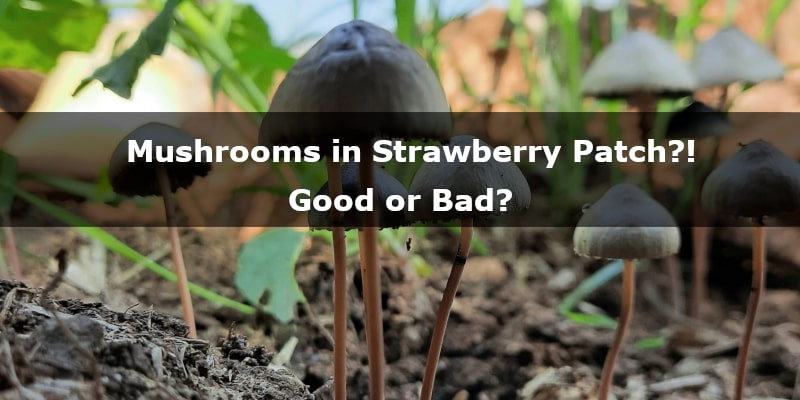So, you have noticed mushrooms in a strawberry patch?
In this article, you will learn everything about this issue, and I will explain to you what you should do with that.
Why Did Mushrooms Appear in Your Strawberry Patch?
Mushrooms appear in your strawberry patch because the soil is well-fertilized and full of nutrients, which makes perfect growing conditions for them.
Mushrooms don’t grow everywhere. They have their own preferences, and sometimes our strawberry patch is the best place for them.
Firstly, mushrooms appear in places where the soil is moist. You water your strawberries frequently, so it’s one of the factors why mushrooms appear next to them.
Mushrooms also like shaded places. Your strawberry leaves make a lot of shade where mushrooms tend to grow.
Mushrooms like to grow in places where the soil is warm, and contains lots of organic matter. That being said, when you fertilize your strawberries or use manure, they have access to feed and grow.
Mushrooms reproduce with spores instead of seeds. The spores with a genetic code of a mushroom are released into the air and carried by the wind to find a place to grow.
Usually, spores will attach to anything that can give them the nutrients they need – dead plants, roots, dead animals, healthy soil, and more.
So, mushroom presence in a strawberry patch is a sign that you fertilize your soil well, and that it’s healthy. Oh, and if you want your strawberries to grow healthier, bigger, and tastier, this fertilizer from Amazon is a must-have.
What’s the Role of Mushrooms for Your Strawberries?
Mushrooms won’t hurt your strawberry plants, as they go into a symbiotic relationship that benefits both.
The role of a mushroom for a strawberry plant is to:
- Help break down fallen leaves
- Provide more water and nutrients
- Decrease tolerance for droughts and disease
Mushrooms in your strawberry path decompose complex organic matter, such as wood chips, rotten leaves, and mulch, into nutrients that your strawberry plants can use.
Moreover, once the mushroom dies, it replenishes the soil with nutrients as it decomposes.
Additionally, mushroom presence creates a communication framework for plants to send distress signals to each other in the event of insect attacks.
That way, your strawberry plants can beef up their defense system before the insects get to them.
What Mushrooms Do Usually Appear in Strawberry Patch?
Some mushrooms growing in your strawberry patch are edible, and some are poisonous. It’s a random thing what type of mushroom grows in your garden. However, you can easily identify them.
The most common mushrooms in a strawberry patch are:
Field mushroom (Agaricus campestris): An edible mushroom, with a short and white stem. It has pink gills when young, and chocolate brown to deep black when older.
Yellow-staining mushroom (Agaricus xanthodermus): A poisonous mushroom, with white, bulbous stem at the base, and broad, hanging off ring. The gills are pink and turning gray
Fly agaric (Amanita muscaria): A very poisonous mushroom. Its cap features broad dome, it’s bright orange or scarlet, sometimes brownish or yellow, flecked with white warts.
Shaggy ink cap (Coprinus comatus): It’s an edible mushroom. You can recognize it by its long stem-up to 8 inches (20 cm), and wide, pale, woolly scales on its cap.
Fairy ring mushroom (Marasmius oreades): An edible mushroom, that has whitish gills. Its cap is pale brown convex dome, becoming floppy, with edges wrinkled or grooved.
Sulphur tuft (Hypholoma fasciculare): Not an edible mushroom. Cap: convex, or domed, bright sulphur yellow with orange tints and a brown center.
Common ochre russula (Russula ochroleuca): An edible one, with a soft, often hollow stem. Its cap is dull beige-yellow, convex when young, expands to flat top, becomes wrinkled or ridged at edges.
Liberty cap (Psilocybe semilanceata): Inedible and hallucinogenic, conical, pale brownish-yellow with greenish tints cap, dark purple-brown gills.
Can Mushrooms in Strawberry Patch Make Your Strawberries Poisonous?
Mushrooms in your strawberry patch, even if poisonous, will not make your plants poisonous. Their poison can’t be absorbed by the fruit.
You need to know that mushrooms won’t make your strawberries poisonous, nor will simply touching your strawberry leaves or fruit transfer poison.
Mushrooms that are poisonous are toxic because of the byproducts of digesting them and because they contain things like aflatoxins.
So, no matter if an edible or poisonous mushroom touches your strawberry- it will not make it poisonous.
If you want to eat a strawberry that was growing next to mushrooms, just rinse it with water.
Mushrooms can poison you only after ingesting the actual mushroom itself.
I would recommend you not to eat any mushrooms from your yard. If you’re not an expert, and you have doubts about identifying the mushroom, don’t eat it!
Should You Remove Mushrooms From Strawberry Patch or Keep Them?
If you have pets or children, and mushrooms that grow in your strawberry patch aren’t esthetical, you should remove them. In other cases, they’re beneficial and help your plants grow.
Like I said before, mushrooms in your yard have lots of benefits as they help your plants grow. Personally, I’d keep them, but there are also reasons to get rid of them.
Some mushrooms are poisonous. If you have children or pets, they can accidentally eat such mushrooms, which is highly dangerous. For their safety, you should remove all the mushrooms.
Also, if you don’t like the appearance of mushrooms, and they ruin the way your yard looks, you might want to remove them, which is completely fine. However, they will grow in other places for sure.
Getting rid of mushrooms is easy. Just wear the gloves, and pull out the mushroom. You can put the mushrooms in the compost bin.
Conclusion
Mushrooms in your strawberry path grow because of high level of nutrients in the soil. They are beneficial because they decompose complex organic matter. They won’t make your plants poisonous.
Sources
farmfromhome.com, tinygardenhabit.com, fallsgarden.com, gardenersworld.com, reddit.com

